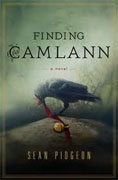Finding Camlann
Sean Pidgeon
book reviews:
· general fiction
· chick lit/romance
· sci-fi/fantasy
· graphic novels
· nonfiction
· audio books
· author interviews
· children's books @
curledupkids.com
· DVD reviews @
curledupdvd.com
newsletter
win books
buy online
links
home
for authors
& publishers
for reviewers

 |
Finding Camlann Sean Pidgeon W.W. Norton Hardcover 352 pages January 2013 |
|
It's hard not to be impressed with Pidgeon's atmospheric debut, an historical
and literary puzzle that mines the ancient landscapes of King Arthur, with its amazing scholarship and its languid, fluid writing. Combining a contemporary love story with ancient poems, letters and diaries, and the fairy-tale stories of Welsh
kings, Finding Camlann
Of course, Arthur is a far deeper mystery than such stories of war and adventure would suggest. Donald sets out to show this by combining the evidence of modern scientific archeology with the position that almost everything that has ever been written about Arthur is wrong. But Donald’s confidence in explaining Arthur is in danger of being derailed when his ex-wife, Lucy Trevelyan, and rival professor Paul Healey unearth a group of old bones at a site called Devil’s Barrow, a few miles from Stonehenge. The discovery adds to Donald’s heightened sense of unease that his efforts to uncover the true origins of his hero may indeed be beyond his reach, a notion echoed by beautiful Julia Llwewllyn, who thinks that Donald’s challenge is as audacious as it is fascinating. Working as a linguist for the Oxford English Dictionary, Julia’s fragile serenity is disturbed by a powerful sense of déjà vu. Julia is unhappy in her marriage to handsome Hugh Mortimer, whose family can be traced back generations in Welsh history. Julia finds her faint irritation at Hugh growing into a more insistent pain, a pain made more pronounced by the unwelcome memories of Welsh nationalist and eccentric scholar Caradoc Bowen. Once Hugh’s mentor, Bowen has in his possession a book of poetry discovered many years before in a manuscript collection at Ty Faenor, the Mortimer family home. One poem in particular, "The Song of Lailoken," is an extraordinary narrative depicting a heroic fight from the distant past that could have been Arthur’s final battle. As Julia and Donald are drawn back into the refined orbit of Caradoc Bowen and the mysteries held within "The Song of Lailoken," the poem becomes a disturbing and dramatic hymn that unlocks the legacy of warrior Arthur and his battle cries across the wild, harsh Welsh rivers and mountains. Meanwhile, Julia knows that Hugh is hiding something from his past. She bemoans his actions, but she also acknowledges this new frisson of excitement as she helps Donald on his search for his lost battle sites. World-weary and threaded with a wistfulness that Donald and Julia want to recapture, their story unfolds against the ghost of Geoffrey of Monmouth, the fifth-century burial of leaders at Devils Barrow, and the enigmatic magician Merlin, who perhaps helped bring from the far west “the great standing stones." The love triangle between Donald, Julia and Hugh gives this tale its romantic poignancy, but Donald and Julia’s intelligent sleuthing reflect the realities of a connection between the archeology finds at Devil’s Barrow and the description of Arthur’s final, noble battle in "The Song of Lailoken." Between the dragon and the raven, both enduring war symbols of the Celtic peoples, and the discovery of a ritualized chalice at Devil‘s Barrow, Donald and Julia cannot escape the perception of larger forces at play. Donald must ponder his own insignificance in a story in which Arthur sleeps somewhere in the other-world, ready to awaken “in the Welshman’s hour of need.” As the story builds toward its climax, Hugh’s shocking back story--and his intention to implicate Julia’s father in a bombing plot--forms the web that defines Julia’s existence and gives explanation to the Welsh blood spilt at the hands of the Mortimer family. The richness of Pidgeon’s research magnifies the thrill of how the whereabouts of Arthur’s tomb will be solved, while Donald soon learns the lesson that, yes, there is indeed truth in history. Most fascinating are Donald’s days spent traveling through the picaresque interiors of England and Wales. Tintagel's bright sunlight and the steep, grassy slopes of Glastonbury reflect a familiar magnetism that draws him back again and again and sets him on a path toward Julia’s complicated life and into the deep, rocky relationships with those she loves. Originally published on Curled Up With A Good Book at www.curledup.com. © Michael Leonard, 2013 |
|
|
|
 Click here to learn more about this month's sponsor! |
|
| fiction · sf/f · comic books · nonfiction · audio newsletter · free book contest · buy books online review index · links · · authors & publishers reviewers |
|
| site by ELBO Computing Resources, Inc. | |
 Using his main character, Donald Gladstone, as his cipher, Pidgeon aims to get back to the origins of this pervasive mythology of Arthur and to understand where, when, and how the legend arose so that we can then gain a proper understanding of British history and of what has come to be known as “the Age of Arthur.” From the outset, Donald’s intention is to introduce a quietly provocative tone and paint a vivid but ambiguous picture that sets the scene for Pidgeon’s controversial retelling of Arthur’s story.
Using his main character, Donald Gladstone, as his cipher, Pidgeon aims to get back to the origins of this pervasive mythology of Arthur and to understand where, when, and how the legend arose so that we can then gain a proper understanding of British history and of what has come to be known as “the Age of Arthur.” From the outset, Donald’s intention is to introduce a quietly provocative tone and paint a vivid but ambiguous picture that sets the scene for Pidgeon’s controversial retelling of Arthur’s story.